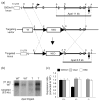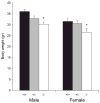Reduced fear and aggression and altered serotonin metabolism in Gtf2ird1-targeted mice
- PMID: 17680805
- PMCID: PMC2883608
- DOI: 10.1111/j.1601-183X.2007.00343.x
Reduced fear and aggression and altered serotonin metabolism in Gtf2ird1-targeted mice
Abstract
The GTF2IRD1 general transcription factor is a candidate for involvement in the varied cognitive and neurobehavioral symptoms of the microdeletion disorder, Williams-Beuren syndrome (WBS). We show that mice with heterozygous or homozygous disruption of Gtf2ird1 exhibit decreased fear and aggression and increased social behaviors. These findings are reminiscent of the hypersociability and diminished fear of strangers that are hallmarks of WBS. Other core features of WBS, such as increased anxiety and problems with spatial learning were not present in the targeted mice. Investigation of a possible neurochemical basis for the altered behaviors in these mice using high-performance liquid chromatography analysis showed increased levels of serotonin metabolites in several brain regions, including the amygdala, frontal cortex and parietal cortex. Serotonin levels have previously been implicated in fear and aggression, through modulation of the neural pathway connecting the prefrontal cortex and amygdala. These results suggest that hemizygosity for GTF2IRD1 may play a role in the complex behavioral phenotype seen in patients with WBS, either individually, or in combination with other genes, and that the GTF2I transcription factors may influence fear and social behavior through the alteration of neurochemical pathways.
Figures






References
-
- Abramow-Newerly W, Lipina T, Abramow-Newerly M, Kim D, Bechard AR, Xie G, Clapcote SJ, Roder JC. Methods to rapidly and accurately screen a large number of ENU mutagenized mice for abnormal motor phenotypes. Amyotroph Lateral Scler. 2006;7:112–118. - PubMed
-
- Amaral DG. The primate amygdala and the neurobiology of social behavior: implications for understanding social anxiety. Biol Psychiatry. 2002;51:11–17. - PubMed
-
- Avgustinovich DF, Lipina TV, Bondar NP, Alekseyenko OV, Kudryavtseva NN. Features of the genetically defined anxiety in mice. Behav Genet. 2000;30:101–109. - PubMed
-
- Avgustinovich DF, Alekseenko OV, Bakshtanovskaia IV, Koriakina LA, Lipina TV, Tenditnik MV, Bondar NP, Kovalenko IL, Kudriavtseva NN. Dynamic changes of brain serotonergic and dopaminergic activities during development of anxious depression: experimental study. Usp Fiziol Nauk. 2004;35:19–40. - PubMed
Publication types
MeSH terms
Substances
Grants and funding
LinkOut - more resources
Full Text Sources
Other Literature Sources
Molecular Biology Databases
Miscellaneous

